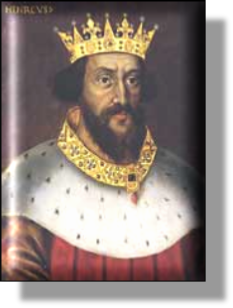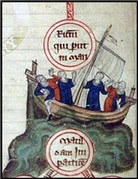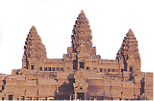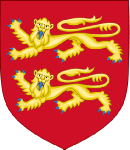


HENRY I 1100 -
1135 (H1) Lived 1069 - 1135
 xxxxxHenry was the youngest son of William I. On
learning of the death of his brother Rufus (William II), he marched
straight to Winchester to seize the royal treasury, and then, without
delay, had himself crowned at Westminster Abbey. He was fortunate in
that his elder brother Robert was on a crusade in the Holy Land at the
time. When he returned to Normandy, Henry was waiting for him and in
1106 defeated his army at the Battle of Tinchebrai - fought,
incidentally on the 40th anniversary of their father's landing in
England. Robert was captured and imprisoned in Cardiff Castle where,
by most accounts, he lived a comfortable life until his death in 1134.
However, it took another victory, this time at Brémule
in 1119 against Robert's son, William Clito, and his ally Louis
VI of France, before Normandy was finally secured for the English
crown.
xxxxxHenry was the youngest son of William I. On
learning of the death of his brother Rufus (William II), he marched
straight to Winchester to seize the royal treasury, and then, without
delay, had himself crowned at Westminster Abbey. He was fortunate in
that his elder brother Robert was on a crusade in the Holy Land at the
time. When he returned to Normandy, Henry was waiting for him and in
1106 defeated his army at the Battle of Tinchebrai - fought,
incidentally on the 40th anniversary of their father's landing in
England. Robert was captured and imprisoned in Cardiff Castle where,
by most accounts, he lived a comfortable life until his death in 1134.
However, it took another victory, this time at Brémule
in 1119 against Robert's son, William Clito, and his ally Louis
VI of France, before Normandy was finally secured for the English
crown.
xxxxxUnlike his brother Rufus,
Henry won the support of the Saxons by granting them a charter of
rights (a forerunner of the Magna Carta), and by marrying Matilda, a
Saxon princess. And in an impressive oath taken at his coronation he
vowed "to abolish all the evil customs with which the realm of
England has been unjustly oppressed." He attempted to keep his word.
Furthermore, he proved an able administrator, and by introducing the
idea of sending out itinerant justices to maintain law and order, he
is generally regarded as the founder of the English system of
justice. In addition, anxious as he was to bring in the taxes, it
was Henry who instituted the Exchequer, that department of the
Treasury which dealt with the collection of taxes. The name comes
from the chequered board on which counters were moved about to add
up the columns of figures. The man put in charge of these
calculations was known as the Chancellor of the Exchequer.
xxxxxAnd, in general, relations
between Church and State took a turn for the better. Fully aware of
the importance of keeping on good terms with the Church leaders -
they were a force that had to be reckoned with - he brought
back the saintly Archbishop Anselm - exiled by his brother Rufus following a quarrel
over the rights of the Church in general and the investiture of
bishops in particular. At first the move was not totally successful.
Within three years the dispute broke out again and Anselm was exiled
for a second time. He was soon recalled, however, and in 1107 a
compromise was reached. The matter did not raise its ugly head again
until 1164 in the reign of his grandson Henry II.

xxxxxThusxHenry's
rule gave England sound government, but any hope that this period of
peace and stability would be continued were dashed in 1120 with the
tragic death of his only son Prince William, drowned in the White Ship disaster. The
accident happened when the ship was driven on to the rocks off
Harfleur in the English Channel. The young prince got away, but it
is said that he insisted on returning to the wreck to rescue his
young sister and the boat he was in capsized.
xxxxxBlame for the sinking of
the White Ship was put on the crew, some of whom, it was alleged,
were drunk at the time. Be that as it may, the death of Prince
William meant that the succession to the throne was virtually up for
grabs. Henry made his barons swear allegiance to his daughter
Matilda, but it was unlikely that they would support her when he was
no longer around. First, and perhaps foremost, she was a woman, and
secondly, she was married to the Count of Anjou, a rival on the
continent and whose territory was next to Normandy. Henry feared the
worst and he had good cause to do so.
|
1100
|
 According
to Inca
legend, the city of Cuzco is founded by their leader, Manco Cápac. This
marks the beginning of an empire which was to govern vast
areas of South America. According
to Inca
legend, the city of Cuzco is founded by their leader, Manco Cápac. This
marks the beginning of an empire which was to govern vast
areas of South America.
|
|
1103
|
Archbishop Anselm goes into exile a
second time following a dispute with the King over the
investiture of Bishops. A compromise is reached four years
later.
|
|
1106
|
Henry defeats his brother,
Robert, at the Battle
of Tinchebrai. As a result, Normandy is
again united with England. Robert, captured in the battle, is
imprisoned for life.
|
|
1111
|
In the continuing
investiture controversy, Henry V of Germany and HRE
kidnaps the Pope, Paschal II, and forces him to acknowledge
his right to appoint and install senior clergy.
|
|
1113
|
The Order of Knights known as
the Hospitallers, founded in Jerusalem to care for sick and
needy pilgrims, takes up arms to defend the Holy Land against
a growing Turkish threat.

In the capital of the Khmer Empire
(in today's Campuchea) work begins on the building of Angkor Wat, a huge, magnificent Hindu temple. The shrine is
not completed until 1150 (ST).
The French scholar Pierre Abelard opens a school for rhetoric, philosophy and
theology in Paris. His writings, though often contentious,
give theology a much needed boost.
|
|
1118
|
Emperor John II Comnenus succeeds
his father, Alexius I, and continues the task of restoring the
fortunes of the Byzantine
Empire. He meets with some success.
After a nine-month
siege, Saragossa is captured from the Moors by Alfonso I the Battler, King
of Navarre and Aragon. He spends his lifetime at war with the
Muslim invaders.
|
|
1119
|
The University of Bologna is founded, one of the oldest and most famous
seats of learning in Europe. In its early years study was
confined to civil and canon law.
|
|
1120
|
Prince William, heir to
the English throne, and king Henry’s only son, is drowned at
sea in the White Ship disaster. This puts the succession to
the throne in serious doubt.
|
|
1122
|
At the Council of Worms a
compromise solution is at last reached between the German King
and the papacy over the appointment and investiture of
bishops.
The Chin Dynasty is founded in
Northern China and within four years the Song Dynasty loses control
of the area, held since 960, and is forced to retreat south of
the River Yangtze. Here it survives until overthrown by the
Mongols in 1279.
|
|
1130
|
The Norman Roger II is crowned King of
Sicily in Palermo cathedral. Under his astute and capable
leadership his kingdom prospers, and his court becomes a
centre of learning.
|
|
1131
|
The death occurs of the
famous Persian poet and mathematician Omar Khayyam.
He is
best remembered for
his poetry made up of quatrains or four lined verse.
|
|
1135
|
Henry I dies on the
1st December. His daughter, Matilda, is his rightful heir, but
his nephew Stephen of Blois seizes the
throne and a long period of civil war follows
|
Acknowledgements
Henry I: c1620, artist unknown
– National Portrait Gallery, London. White Ship:
produced for the Corporation of the City of London c1320, artist
unknown – originally in the British Library, London. Coat of
Arms: licensed under Creative Commons. Author:
Sodacan – https://commons.wikimedia.org.
H1-1100-1135-H1-1100-1135-H1-1100-1135-H1-1100-1135-H1-1100-1135-H1-1100-1135-H1







Timewise
Traveller is a free non-profit resource. However, if you have found it
of interest/value, and would like to show your appreciation, the author
would welcome any contribution to Cancer Research UK.
To visit our Cancer Research page and make a small donation, click













 According
to
According
to 
